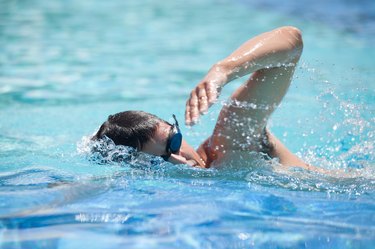
For the beginner or intermediate swimmer, bloating, belching and stomach pains often follow a long swim. This is commonly due to aerophagia, or the act of ingesting air while swimming. The potential causes of aerophagia while swimming are varied, but technique, eating habit and pre-swim meals contributing to this condition. With these potential causes in mind, try targeting each to help determine which one is causing you to swallow air while swimming.
Step 1
Eliminate chewing gum and carbonated drinks from your diet. Limit your intake of both if they cannot be eliminated.
Video of the Day
Step 2
Limit your intake of greasy foods, chocolate, caffeinated beverages and mints, all of which may contribute to stomach discomfort while swimming.
Step 3
Reduce the amount that you eat before swimming, and avoid eating altogether within a few hours leading up to your trip to the pool. Eating a large meal before swimming can trap some air in your stomach. Changing from a vertical to horizontal position may cause this air to shift, potentially increasing your discomfort.
Step 4
Eat smaller meals more frequently throughout the day and take smaller bites while eating. Avoid talking while eating and try to monitor how much air you take into your mouth with each bite.
Step 5
Limit your intake of dairy and simple sugars before heading to the pool, as both of these increase gas production and may trap gas in your stomach.
Step 6
Calm down before a swim. Try stretching, performing yoga or doing other relaxing activities. Being nervous may cause you to take larger gulps of air than normal, potentially increasing the amount of air your swallow while swimming.
Step 7
Control your breathing and avoid taking large gulps of air. Increase your breathing rate to avoid taking in more air than you need. For example, if you typically breathe on every third stroke while performing the front crawl, switch to taking smaller breaths with every other stroke.
Step 8
Breathe through your nose whenever possible. While there is an association between your mouth and swallowing, no such link exists with your nose. Practice performing different strokes while breathing through your nose.
Tip
While it may be easier to breathe through your nose while performing the backstroke or breaststroke, it is possible to train yourself to do the same while performing other strokes.
Make any changes before swimming in a meet. While altering your breath frequency or breathing techniques may slow you down at first, this loss in speed will become minimal with practice. In addition, reducing your discomfort due to aerophagia may result in speed gains greater than any loss in speed that you experience.
Warning
If you can't get the hang of swimming without ingesting air that leads to discomfort, consider changing your cardio exercise. Exercises such as jogging and cycling are a suitable alternative.
Video of the Day